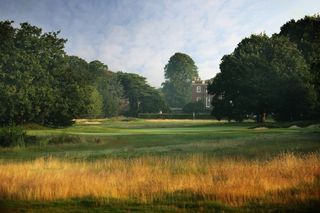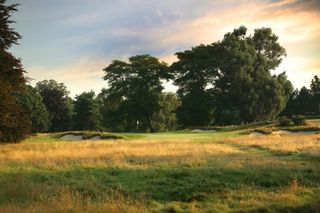The Richmond Golf Club secures its future
The 125-year old club has bought the freehold of its site


A deal with The Crown Estate sees the 125-year old club buy the freehold of its site
The Richmond Golf Club has bought the freehold of its site from The Crown Estate. David Hill, chairman of the club during the negotiations says: “When some clubs are closing, selling land or changing the rights of their members, we are delighted that the future of our club is now even more secure.”
The purchase was financed by The Richmond Golf Club members themselves, through loan notes, with around 300 members contributing. The move is part of the Crown Estate policy of reducing its golf portfolio.
“What is most pleasing is the way that it has all been done,” says Mr Hill. “Under the new arrangements, all members will continue to hold an equal stake, regardless of their contribution to the financing of the acquisition.
“Potential new members should not be put off,” he added, “as they will be welcome to, but will not be expected or compelled to, participate in the loan note scheme.“
In 2009 the club dropped its all-male membership rule and has been promoting ladies and junior golf. Visitors are welcome to play at The Richmond Golf Club most weekdays and on weekend afternoons.
The club will retain royal links as the Duke of York is the club patron. Previously this position was held by the Queen Mother. Her husband, George Vi had been a member of the club and, when Duke of York, had been club captain in 1924.
Get the Golf Monthly Newsletter
Subscribe to the Golf Monthly newsletter to stay up to date with all the latest tour news, equipment news, reviews, head-to-heads and buyer’s guides from our team of experienced experts.
Princess Alexandra attended one of the club’s 125th anniversary celebrations earlier this year and unveiled two paintings of the clubhouse - one depicting it in summer, the other when under snow - by Ken Howard.
As a result of the sale, the members’ club now owns their attractive par-70 course in Sudbrook Park, which is alongside Richmond Park, and their clubhouse, Grade I-listed Sudbrook House.

This house has been commissioned by the Duke of Argyll in 1715 to be his London home. Later, after a spell as a gentleman’s club and a hotel, became The Richmond Golf Club’s clubhouse in 1893.
The course is an attractive parkland one. Originally the design of Tom Dunn, other hands have played a part in reshaping it, including those of Harry Colt.
A recent refurbishment of all the bunkers on the course has brought a Colt feel back to the design. The result is a series of attractive, tree-lined holes, with raised bunkers.
Indeed, much work has been done on the course in the past five years, under the direction of golf architects Thomson Perrett and Lobb. The Richmond Golf Club won first place in the Golf Inc. Renovation of the Year Awards of 2013.
The course is not long - not quite reaching 6,100 yards even off the tips, and the fours par 5s are all under 500 holes. But the holes overall have an attractiveness and variety to then.

The club is famed for its wartime local rules. This club is not the only one to have to adapt to wartime conditions. But here seems to have a happier conclusion than the saga of Sunningdale and its honour boards during the First World War.
The Richmond Golf Club had a set seven local rules to cope with bombing, the last of which runs: “A player whose strike is affected by the simultaneous explosion of a bomb may play another ball from the same place. Penalty one stroke.”
The first bit seems fair but the second? This rule does not actually offer the golfer anything new, it merely reworks the rule that players can declare a ball unplayable, and replay the previous shot at the cost of a stroke.
Rule 5 states: “A ball moved by enemy action may be replaced, or if lost or destroyed, a ball may be dropped not nearer the hole without penalty.”
Contributing Writer Golf courses and travel are Roderick’s particular interests and he was contributing editor for the first few years of the Golf Monthly Travel Supplement. He writes travel articles and general features for the magazine, travel supplement and website. He also compiles the magazine's crossword. He is a member of Trevose Golf & Country Club and has played golf in around two dozen countries. Cricket is his other main sporting love. He is the author of five books, four of which are still in print: The Novel Life of PG Wodehouse; The Don: Beyond Boundaries; Wally Hammond: Gentleman & Player and England’s Greatest Post-War All Rounder.
-
 'Gator Netting Is In Place' - Chevron Championship Venue Prepared For 'Safe' Winner's Jump
'Gator Netting Is In Place' - Chevron Championship Venue Prepared For 'Safe' Winner's JumpA tradition which began at the tournament's previous home could continue this year - if the champion is feeling brave enough...
By Jonny Leighfield Published
-
 New Balance 997 SL Golf Shoe Review
New Balance 997 SL Golf Shoe ReviewNew Balance produce some extremely stylish footwear and, in this review, Matt Cradock takes their spikeless 997 SL onto the course
By Matt Cradock Published
-
 Should You Play A Yellow Golf Ball?
Should You Play A Yellow Golf Ball?We discuss if switching to a yellow golf ball could help your game
By Joel Tadman Published
-
 Arccos Appoints Lou Stagner As Data Insights Lead
Arccos Appoints Lou Stagner As Data Insights LeadThe 'golf stats pro' will be helping Arccos take its insights to the next level.
By Dan Parker Published
-
 Nike Launches NOCTA Golf Collection
Nike Launches NOCTA Golf CollectionTake a look at the new golf collection from Nike and music artist Drake.
By Sam Tremlett Published
-
 Ping Unveils Team Europe Solheim Cup Collection
Ping Unveils Team Europe Solheim Cup CollectionCheck out what Team Europe will wear when trying to win the Solheim Cup once again.
By Sam Tremlett Published
-
 adidas No-Dye Footwear Collection Revealed
adidas No-Dye Footwear Collection RevealedCheck out the new environmentally-conscious 'No-Dye' Collection from adidas.
By Sam Tremlett Published
-
 Titleist Launches Team Europe Ryder Cup Special Editions
Titleist Launches Team Europe Ryder Cup Special EditionsTitleist has launched its European Ryder Cup merchandise
By Dan Parker Published
-
 Nominate Your Teacher: Is Your Golf Coach One Of The UK's Best?
Nominate Your Teacher: Is Your Golf Coach One Of The UK's Best?Nominate them to be included in our list of top instructors
By Elliott Heath Published
-
 Take Part In Our Survey With Prize Draw!
Take Part In Our Survey With Prize Draw!Tell us what kind of golfer you are in our survey, for the chance to win a £250 or $300 Amazon voucher!
By Elliott Heath Published